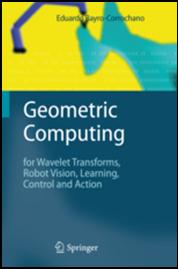

|
BOOKSBOOKSBOOKS
Geometric Computing for Wavelet Transforms, Robot Vision, Learning, Control, and Action
by Eduardo Bayro Corrachano Springer, 2010
Reviewed by Dietmar Hildenbrand (Germany) |
|
This book presents the theory and engineering applications of geometric algebra, a very powerful mathematical system. Part I of this book describes the power of geometric algebra in a very effective way. Its elegance is apparent especially in the description of the Maxwell Equation in only one very simple formula. Part II describes a broad range of algebras, ranging from Euclidean algebra, motor algebra, Lie algebra, etc., to conformal geometric algebra. While most of these algebras are interesting from a more historical or more mathematical point of view, Part II ends up with the most important current algebra for engineering applications, the conformal geometric algebra. This very helpful mathematical system is explained very thoroughly with the whole background and important concepts like null space descriptions of the objects. Also, the conformal transformations are described in a very intuitive way. Part III shows that the author is a profound expert in areas like Fourier transform and neural computing based on geometric algebra. Chapter 8, for instance, highlights the properties of different Fourier and wavelet transforms and their applicability for image analysis. Very helpful for the understanding of the use of geometric algebra in computer vision is chapter 9. It culminates in the elegant modeling of omnidirectional vision using conformal geometric algebra. Parts IV, V and VI are dedicated to the application of geometric algebra in areas like robotics, image processing, computer vision, neurocomputing and medical computing. All these applications show the experience of the author in applying geometric algebra to real world applications. The results highlight that geometric algebra is a mathematical tool that can be used very advantageously in many engineering scenarios. For an overall understanding of the benefits of geometric algebra chapter 2 is especially important. It is very helpful in order to understand the principles on how to apply geometric algebra to problems in perception and action systems. Another very important overview chapter is chapter 7, describing the principles of how to implement geometric algebra algorithms very efficiently. This book has a real potential to convince a big audience of the benefits of using geometric algebra in engineering applications, and I hope that it will be successful. Remark: in the next edition of this book the term “CLUCal” should be corrected to “CLUCalc” as well as “Hildenbrand” with “n”. |
|
Click on the above image to go to the SpringerLink web page for this book and read it online. |
